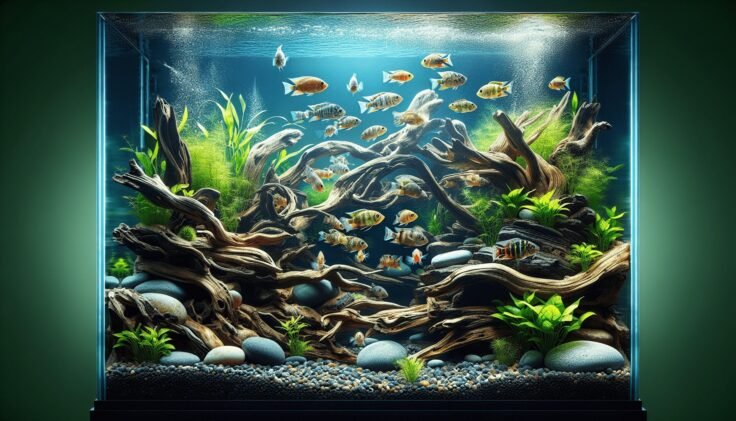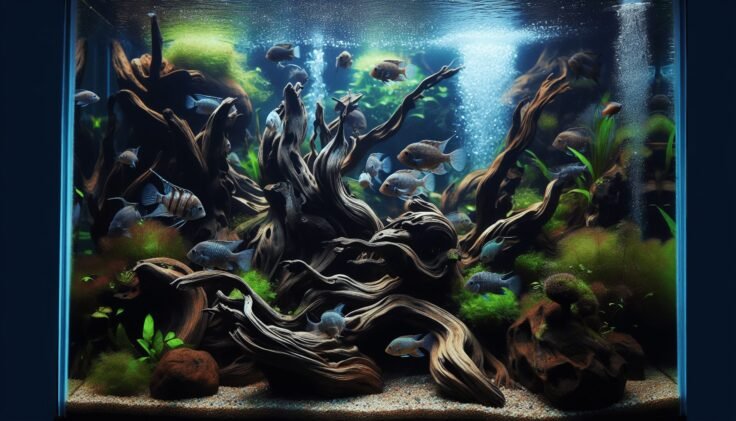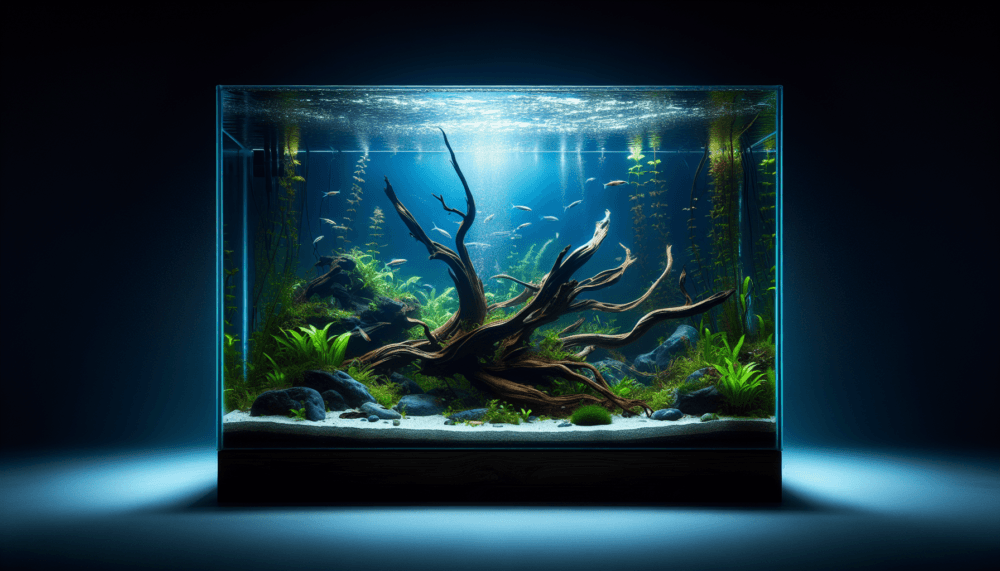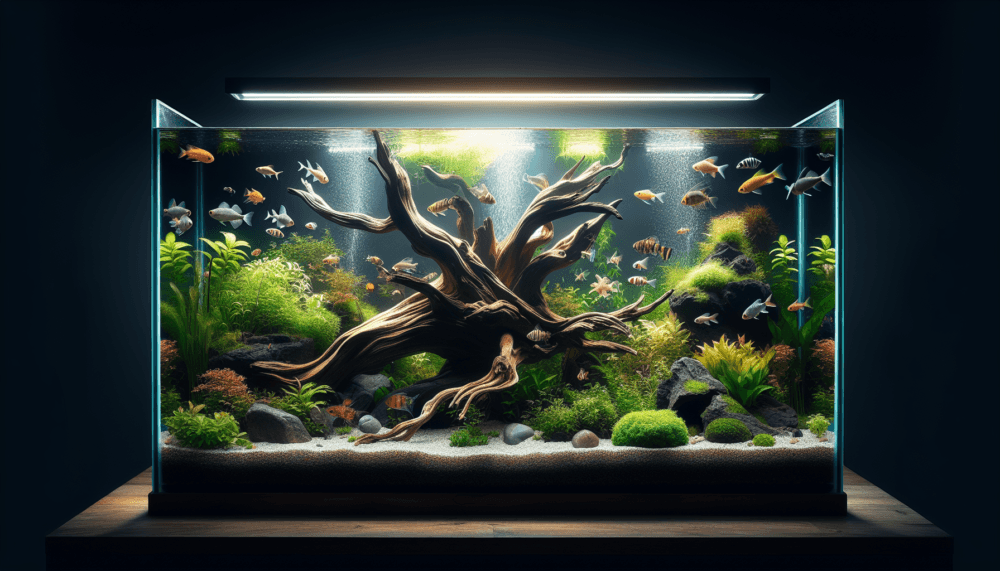Have you ever thought about combining the natural beauty of driftwood with the vibrant and colorful world of cichlids in your aquarium? Setting up a driftwood cichlid tank can be a rewarding endeavor, creating a stunning aquatic environment that mimics the beauty of nature. Let’s embark on this journey together to understand how you can create and maintain a serene and captivating space for your cichlids.

Understanding Driftwood and Cichlids
Before you start setting up your tank, it’s essential to understand both driftwood and the unique needs of cichlids. Driftwood not only adds a natural aesthetic to your aquarium, but it also provides practical benefits for the fish. On the other hand, cichlids are a diverse group of fish with distinct needs and behaviors that you’ll want to accommodate.
What is Driftwood?
Driftwood refers to any wood that has been washed onto the shore of a sea, a lake, or a river. In an aquarium, driftwood serves multiple purposes. It creates a natural habitat for fish and invertebrates, offers hiding spots, and sometimes releases tannins into the water. These tannins can soften and slightly acidify the water, mimicking the fish’s natural environment and sometimes giving the water a tea-colored hue, which many cichlids prefer.
Discovering Cichlids
Cichlids are a large family of fish with over 1,600 species known to date. They inhabit various regions worldwide, but the majority come from Africa’s lakes, especially Lake Malawi, Lake Tanganyika, and Lake Victoria. Their charming personalities, striking colors, and diverse species make them a favorite among aquarists. Each species has its own unique set of requirements, but most cichlids thrive in warm, slightly alkaline water.
Setting Up Your Driftwood Cichlid Tank
Creating an ideal habitat for your cichlids using driftwood involves thoughtful selection and preparation. This ensures your tank not only supports healthy fish but also simulates a natural environment that you and your fish will appreciate.
Choosing the Right Driftwood
Selecting suitable driftwood is a crucial step in setting up your aquarium. When choosing driftwood, consider these factors:
Type of Wood: Hardwoods like Malaysian or Mopani wood are typically preferred for aquariums due to their durability and density. These woods sink easily and resist decay.
Size and Shape: Choose pieces that will fit comfortably in your tank, leaving enough space for swimming and territorial boundaries.
Source: Ensure that the driftwood is aquarium safe. Pieces from pet stores are usually safe to use, but if you collect your own, ensure it’s properly cleaned and treated.
Preparing Driftwood for Your Tank
Thorough preparation of driftwood is essential to prevent water pollutants and unwanted tannins. Here are steps to prepare driftwood:
Rinse and Scrub: Clean the driftwood with warm water and a stiff brush to remove any dirt, debris, or pests.
Boiling: If possible, boil the driftwood for at least 1-2 hours. This process will help release trapped tannins and kill potential pathogens.
Soaking: Let the driftwood soak in a container of water for several days, changing the water daily. This will continue to leach tannins and ensure the wood is waterlogged and ready for the tank.
Understanding Cichlid Needs
When setting up your cichlid tank, keep in mind these essential needs:
Space: Cichlids are territorial and require plenty of space. Overcrowding can lead to aggression and stress.
Aquascape: Mimic their natural habitat with rocks, caves, and the driftwood you’ve prepared, creating territories and hiding spots.
Water Conditions: Aim for warm water temperatures between 76°F to 82°F and maintain a pH around 7.8 to 8.4, depending on the species.
Acclimating Cichlids to Their New Home
Acclimation is crucial for introducing cichlids to their new environment safely. Start by floating their transport bag in the aquarium to equalize temperatures. Gradually mix tank water into the bag over 30-45 minutes. This method reduces stress and allows the fish to become comfortable in their new home.
Creating a Harmonious Environment
A successful cichlid tank goes beyond setup; it requires nurturing a balanced ecosystem. From community dynamics to maintaining water quality, achieving harmony in your aquarium leads to healthy, vibrant cichlids.
Managing Territorial Behavior
Cichlids can exhibit territorial behavior, especially during breeding. To prevent aggression:
Diversify Environment: Use decor, rocks, and plants to create visual barriers and separate territories.
Uniformly Distributed Hiding Spots: Ensure there are plenty of places for fish to retreat if they feel threatened.
Diet and Nutrition
Feeding your cichlids the right diet is crucial for their health and color vibrancy. Their dietary requirements vary by species: some are herbivores, others carnivores, and some omnivores. Provide a balanced diet that adheres to their natural eating habits:
Herbivores: Offer spirulina flakes, blanched vegetables, or algae-based foods.
Carnivores: Feed them protein-rich foods like bloodworms, brine shrimp, or specialized pellets.
Omnivores: A mix of plant-based and protein meals will suffice.
Here’s a quick reference table for cichlid diet types based on their species:
| Cichlid Type | Primary Diet | Food Recommendations |
|---|---|---|
| Herbivorous | Plant-based | Spirulina, algae wafers, blanched vegetables |
| Carnivorous | Protein-based | Bloodworms, brine shrimp, high-protein pellets |
| Omnivorous | Mixed Diet | Balanced mix of plant-based and animal-based foods |
Monitoring Water Quality
Maintaining pristine water conditions is vital for cichlid health:
Filtration: Use a powerful filter to handle biological waste and maintain water clarity.
Regular Testing: Frequently test the water for ammonia, nitrate, nitrite, and pH levels. Keeping track will help you act promptly on imbalances.
Consistent Water Changes: Change 20-30% of your tank’s water weekly to remove waste and replenish minerals essential for fish health.
Troubleshooting Common Challenges
Every aquarium enthusiast encounters challenges. Understanding common issues and knowing how to address them will ensure your driftwood cichlid tank thrives.
Algae Overgrowth
Algae can be beneficial in moderation but becomes a problem when it takes over:
Lighting Control: Adjust the amount and duration of lighting, as excessive light encourages algae growth.
Balance Nutrients: Introduce plants to absorb excess nutrients, and limit phosphate levels by not overfeeding fish.
Illness and Disease
Cichlids are prone to diseases if water quality drops or they are stressed:
Quarantine New Fish: Isolate any new additions to your tank for a couple of weeks to prevent spreading diseases.
Recognizing Symptoms: Keep an eye out for changes in behavior, spots, or unusual movements. Early detection and treatment are key to recovery.
Medication: Use aquarium-safe medications if necessary, and follow dosage instructions carefully.
Driftwood Maintenance
While driftwood is a beautiful addition, it needs attention:
Prevention of Fungus Growth: If white fungus appears, remove it promptly, scrub the wood, and perform water changes.
Anchor the Wood: Ensure driftwood is secure and not buoyant to prevent it from uprooting plants or disturbing the substrate.

Conclusion
Crafting a driftwood cichlid tank is both an art and a science, merging the natural allure of driftwood with the lively world of cichlids. By understanding their behaviors and needs, carefully planning your tank setup, and diligently maintaining water quality, you can create a stunning, harmonious aquatic environment. This endeavor will not only bring aesthetic beauty into your space but will also offer you endless joy and fascination as you observe these beautiful fish thrive in their new home. Remember to enjoy the process, experiment with your aquascaping, and appreciate the unique ecosystem you’ve created. Your effort and dedication will surely be rewarded with vibrant fish and a mesmerizing underwater scene.





















